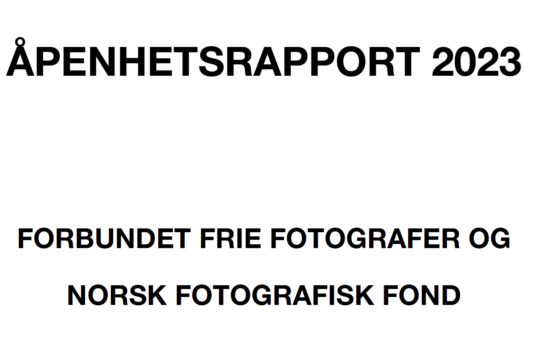
History
History
FFF was founded as a result of the struggle to highlight photography as a form of art in Norway. Bjørn Winsnes was the first photographer to receive an artist grant in 1969. Two years later photography was accepted at the annual Høstutstillingen for the first time, but Kåre Kivijärvis photographs were listed as paintings in the catalogue. At that time, photography was most probably to be found exhibited in cafes and such places, and would not be presented in galleries until quite some time later. This led to a fight for the recognition of photography on the same level as painting and other traditional art forms. Kivijärvi and others took the initiative to establish an artist organization in 1974, and at the first meeting of Forbundet Frie Fotografer (FFF), on the 19th August 1974, Kåre Kivijärvi, Åge Fermann, Fritz Solvang, Robert Meyer, Arnt Sneve, Knut Evensen and Imre Hancz were present.
The name “frie” (free) was to refer to the non-commercial photography, and in one of the statutes it is written: “FFF shall promote free artistic photography as a personal form of expression in Norway.” The photographer Jamie Parslow became the organizations first member, and up until the first general assembly in 1977, new members were voted in during the members meetings. From 1977 and onwards new members were accepted through an elected jury
FFF organized the exhibition Fotografi her og nå (Photography Here & Now) at the Henie Onstad Art Center for their five year anniversary in 1979. The exhibition showed a cross section of the members work. The same year they also organized a curated exhibition to Høstutstillingen with works from 38 photographers. Photography has been part of the exhibition every year since then, listed in the category other technics.
According to the statutes, FFF was to organize an open exhibition of fine art photography during spring every year. Fotografisk Vårutstilling (Photographic Spring Exhibition), today known as Vårutstillingen (Spring Exhibition), was organized for the first time in 1976, presented at Oslo Kunstforening. In 1988 the exhibition was presented at Fotogalleriet, which became FFF´s main venue for the show. Gradually the jury got more power to put together an exhibition showing a certain theme or a tendency.
In 1976 the establishing of a photographic gallery was up for discussion, and a committee was appointed to evaluate the possibilities. FFFs ambition was to create an independent gallery with its own board, that still would have an organizational connection to FFF. Fotogalleriet opened in 1977, but it was not until 1979 that FFF joined as co-founder. In 1982 FFF got their first offices in Steenstrups gate, which they rented from Fotogalleriet, and in 1988 Ingrid Bjerke was employed as FFF´s first director. Until then the position had been unpaid, as part of the chairman´s tasks.[1]
FFF today
In the 1970´s and 80´s, FFF aimed to better the photographers possibilities to apply for grants and exhibit their work, and to establish a national museum for photography as well as an education for photographers. Several of these goals have been reached today, through FFFs involvement with Fotogalleriet, Norsk Fotografisk Fond (Norwegian Photographic Fund - NoFoFo) established in 1979, the Institute for Photography in Bergen, which opened in 1990, and the Preus museum, established for photography in 1995. Today´s work involves informing about social and economic rights and possibilities for support and funding for artists working with camera-based art. FFF is responsible for the annual allocation of the Statens Kunstnerstipend (Government Grants), and will each year consider applications for these grants submitted from the photographic art community. FFF also organizes events such as seminars and professional forums, and is responsible for the annual Fotobokfestival Oslo established as Flere sider Fotografi in 2009 and the annual Vårutstillingen (Spring Exhibition), established in 1976.
From 2010 one of the participating artists at the Spring Exhibition is awarded BHK's (Bildende kunstneres hjelpefond) prize for photographic art to the sum of 100.000 NOK. The purpose is to highlight the Spring Exhibitions significance for photographic works, and the prize is awarded to the artist with work considered most significant for the exhibition.
FFF is now located above Fotogalleriet in Møllergata, managing an atelier community, a scanner room and a guest apartment. From 2012 FFF also offers residencies in collaboration with the Swedish CFF (Centrum för fotografi) and the Finnsih Photographic Gallery Hippolyte/Union of Artist Photographers under the heading Focus A-I-R. The goal is to strengthen the network between artists in the Northern countries.
FFF´s political work is still highly relevant today. For an exhibition at Fotogalleriet in 2010 an artist was delayed in the Norwegian costumes with his work. Even though he could show them the exhibition contract with Fotogalleriet, he was held back several hours on the boarder where three costums officers were discussing whether his photographs were art or not. This despite the fact that the Customs Service published this circular in 2004 after another photographer experienced similar treatment at the boarder: "In order for a photograph to be considered an artistic photography by VAT regulations, it must be taken by the artist, developed by the artist or under his supervision, signed and numbered in a number limited to 30, regardless of formats and substrates." This clearly arguments for the importance and the continuation of the work by FFF to inform and educate about photography as an art form.
[1] Directors: Ingrid Bjerke (leave: substitute Per Berntsen, Wiebe Kunst), Kåre Stang, Eva Klerck Gange, Arild Hartmann Eriksen, Bjørn Westad, Karianne Kampevold Larsen, Kjersti Solberg Monsen, (leave: substitute Petrine Lillevold Vinje)

